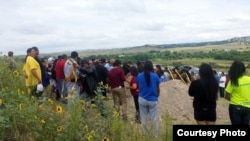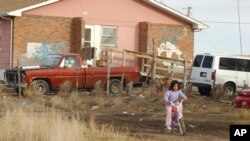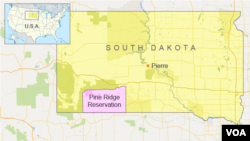Native Americans have always had a higher suicide rate than non-natives in the U.S., and the number is rising, especially on Pine Ridge Indian Reservation, home of the Oglala Lakota people.
This year alone, more than 100 Pine Ridge youths between the ages of 9 and 24 attempted suicide. At least 19 succeeded, said Keith Janis, a Lakota environmental and political activist whose ancestor rode with the legendary 19th Century Lakota warrior, Crazy Horse.
What drives these children to their own death?
“I think that the number one reason is the extreme poverty and culture of violence that the federal government instituted here, through all the years of oppression and forced assimilation into non-Native culture. Basically just putting us into reservations which make us invisible,” Janis said.
Last February, Janis’s own granddaughter Santana, age 12, hanged herself in a building adjacent to her house.
“It was a horrible, horrible experience,” he said, his voice breaking.
Janis set up a private Facebook group called “Santana House” to function as a virtual suicide response network. He carefully monitors Facebook accounts belonging to Pine Ridge youth, looking for signs of trouble. One suicide, researchers say, can actually prompt others to try to kill themselves, especially where there is sensational media coverage.
“We see Lakota children really grieving their friends who have killed themselves,” he said. “They will post suicidal thoughts like, ‘See you soon,’ or ‘I’m right behind you.”
When he sees such comments, he alerts adult members of the group whom he calls ‘God’s Angels.' They step in to offer the child messages of hope, love and support.
One day, he hopes to build a real building to shelter Pine Ridge youth at risk.
Life on the ‘Rez’
Pine Ridge is in Shannon County, South Dakota, a hundred miles away from the nearest town, Rapid City, S.D. -- unless you count Whiteclay, Nebraska, population 14, sitting just a few hundred feet over the border from the reservation. Whiteclay’s sole economy depends on selling beer to Pine Ridge residents – to the tune of 4.5 million cans a year.
Forty thousand people live on Pine Ridge, though only a portion of them are actually counted in the official census. That’s because it’s hard to count the homeless or those who live off marked roads.
There’s no industry or commerce on the reservation, which accounts for its 80-90 percent unemployment rate and an average per capita income of $3,000 a year.
“Some people say it’s like a third world country,” said Janis. “I actually think the more correct term would be ‘fourth world,’ because at least the third world nations have other governments and other non-governmental organizations really reaching out to uplift those countries and spawn development.”
Life expectancy on Pine Ridge is the second lowest in the Western Hemisphere. Infant mortality is 300 percent higher than elsewhere in the U.S. The majority of Lakota struggle with alcoholism. More than half of all adults on Pine Ridge suffer from diabetes and related illness.
Housing is inadequate on Pine Ridge, often lacking basics like electricity, heat or running water. It’s not unusual to see more than two dozen people living in a three-bedroom house, said Janis.
‘Feed my children’
“Food is a big problem,” said Jeri Baker, Director of One Spirit, a non-profit organization that provides food, heating and other services to the Pine Ridge Lakota community. “All of Pine Ridge depends on food subsidies.”
There’s only one grocery store on the reservation, but few can afford its prices, she said.
“The kids tell me what it’s like to go to bed, just so they can forget about the hunger pangs in their stomach,” she said.
“I see grandmothers who tell me, ‘Feed my grandchildren, don’t worry about me.’ They tell me that they send their kids to school even when they are sick because there’s food there. They send their kids to [funeral] wakes even if they don’t know the person who died, because they know there is food there,” Baker said.
Lately, there have been a lot of wakes as kids give in to the hopeless of their situation.
No place to go
About 30 percent of Pine Ridge residents are homeless. Many of them are children.
Pauletta Red Willow runs the Oglala Sioux Tribe Emergency Youth Shelter at Pine Ridge, an eight-bed facility that can provide up to 60 days shelter for youth between the ages of 12 and 17.
“The youth that come to our program here suffer from a variety of problems,” Red Willow said. “We deal with sexual abuse, sexual assault, physical abuse, neglect, domestic violence. We have a lot of post-traumatic stress disorder, substance abuse and other mental health issues. And we just don’t have the resources to handle them.”
The shelter relies predominantly on federal funds, which are administered by the state of South Dakota.
“The state gets a block grant from the Feds of $92.10 per child per day,” said Red Willow. “And by the time it filters to us, it’s $27.50 a day to provide shelter, care, food, utilities to eight children.”
After 60 days, residents must leave the shelter. Those that can’t find housing may end up in juvenile detention facilities.
Broken promises
The Lakota tribe is one of several known collectively by the name "Sioux." The Oglala of Pine Ridge are a sub-tribe who, by the mid-19th century, controlled a large swath of the Great Plains around the Black Hills.
As settlers moved further westward during the 1800s, the U.S. government negotiated a variety of treaties by which the Lakota agreed to confine themselves to Pine Ridge in exchange for rationed goods and services -- food, clothing, tools.
“Among other things, those treaties and promises said, ‘We will provide for your health care. We will provide for law enforcement, shelter, education and other services,’” said Byron Dorgan, a former U.S. senator from North Dakota who once chaired the Senate Indian Affairs Committee. “But the fact is, we just haven’t done it.”
In 2011, Dorgan donated a million dollars of his unused campaign funds to found the Center for Native American Youth at the Aspen Institute in Washington, D.C. to advocate for better health, safety and well-being of Native American children.
The problem, he explained, is that the government long ago established programs like the Bureau of Indian Affairs and Indian Health Service to meet the needs of Native communities, but those programs are sorely under-funded.
“I did a lot of hearings on this, “said Dorgan, “and the hearings suggest that about one half of the medical needs are being met. That means that half of them are not met. And that means that there is full-scale health care rationing going on in Indian reservations, something that would normally be front-page national news, but it’s not when it’s happening to Native Americans.”
The Bureau of Indian Affairs was not able to accommodate VOA’s request for an interview. But a spokesperson said in an emailed statement that suicide prevention remains an area of “intense focus” for the Indian Health Service, which has recently created three new case worker positions to supplement the existing staff of nine behavioral health professionals on Pine Ridge.
Earlier this year, the White House launched its Generation Indigenous initiative to help improve the lives of Native youth through new investments and increased engagement with Native youth.
President Obama's FY 2016 budget proposal calls for increased investments across Indian country, calling for $20.8 billion to fund a range of federal programs to serve the nation’s 566 registered tribes.











